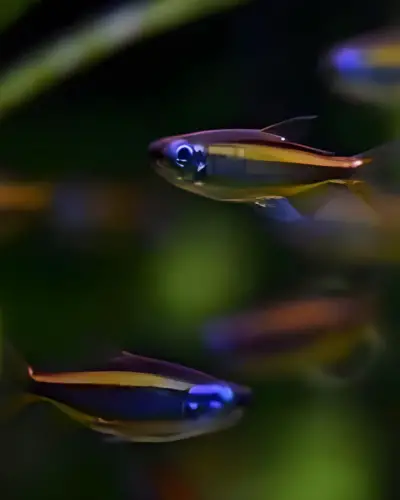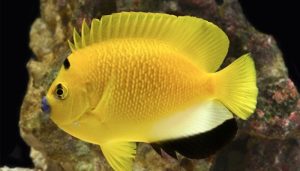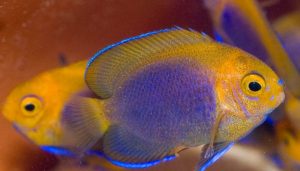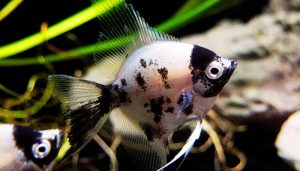Have you ever seen a fish so mesmerizing that it feels almost unreal? The Blue Eyed Congo Tetra, with its shimmering scales and striking blue eyes, is one such wonder. This rare freshwater species captivates aquarists worldwide, but what makes it so special?
This care guide covers everything you need to know about the phenacogrammus aurantiacus. Native to the Congo River Basin, this fish is prized for its vibrant colors and peaceful nature.
Learn about its habitat, diet, tank requirements, and expert care tips to keep this beauty thriving.

Owning one of these rare tetras is a rewarding experience, but proper care is essential. Aquarium expert Dr. Paul Loiselle emphasizes the importance of water quality for their health.
So, let’s dive into the world of the Blue Eyed Congo Tetra and discover how to care for this genus aquatic gem!
Table of Contents
ToggleHow big do Blue Eye Congo Tetras grow?
Blue Eye Congo Tetras typically grow to a size of about 2 to 3 inches (5 to 7.5 cm) in length, making them a slender addition to your aquarium. Their size can vary slightly depending on various factors such as diet, water quality, and overall care.
In a well-maintained environment with a varied diet that includes live or frozen foods like brine shrimp, daphnia, bloodworms, and high-quality flake food, these fish can thrive and reach their full potential. It’s essential to house them in large groups to ensure they feel secure, as they are naturally reserved and prefer the company of their own kind.
As your Blue Eye Congo Tetras grow, they will display their beautiful dorsal and caudal fins, which contribute to their graceful swimming patterns. Providing them with plenty of swimming space and hiding spots within the aquarium can help them feel comfortable and promote healthy growth.
When considering tank size, it’s advisable to have at least a 20-gallon aquarium to accommodate a small school of these fish comfortably. Regular monitoring of their growth and health can help you ensure they are thriving in their aquatic environment.
Are Blue Eye Congo Tetras aggressive?
Blue Eye Congo Tetras are known for their peaceful nature and are generally not aggressive. They exhibit a naturally reserved disposition, which makes them ideal for community aquariums.
These fish tend to dart away from larger or more aggressive species, preferring the company of smaller fish or other congeners like corydoras catfish.
However, it is important to avoid pairing them with overly aggressive fish, as this can lead to stress and a decline in health.
The Best Tankmates for Blue Eye Congo Tetras
When selecting tankmates for Blue Eye Congo Tetras, it is essential to choose peaceful species that share similar water parameters. Ideal companions include other characins, such as the lamp eye Congo or various species of corydoras, as they thrive in similar environments.
Additionally, smaller freshwater fish like guppies or Rasboras can make excellent tankmates, providing a vibrant community atmosphere without causing stress. Avoid larger or more aggressive fish, which may view the African tetras as prey.
In a well-planned aquarium, the presence of compatible tankmates can enhance the beauty and dynamics of your aquatic ecosystem. When introducing new fish, it’s wise to monitor interactions closely during the acclimation period to ensure harmonious coexistence.
A diverse community can also encourage natural behavior in Blue Eye Congo Tetras, allowing them to display their playful darting movements. Creating a balanced environment with groups of at least six of each species can significantly improve the overall well-being of all fish in the aquarium.
Blue Eye Congo Tetra Water Parameters
Maintaining the right water parameters is crucial for the health of Blue Eye Congo Tetras. They thrive in slightly acidic water with a pH range of 6.0 to 7.5 and a temperature between 75°F to 82°F (24°C to 28°C).
Regular water changes and careful monitoring of ammonia, nitrite, and nitrate levels are essential to prevent stress and diseases. These fish prefer a well-filtered aquarium with dense of floating vegetation, which mimics their natural habitat in the Congo River Basin.
Providing a stable environment with consistent soft water parameters is vital for their well-being. Using a quality water conditioner can help achieve optimal conditions, while live plants can contribute to water quality and provide hiding spots.
Additionally, it’s best to avoid sudden changes in water chemistry, as this can lead to health issues in Blue Eye Congo Tetras. By paying attention to their specific needs and maintaining a balanced ecosystem, you can enjoy the beauty and activity of these stunning fish in your aquarium for years to come.
Blue Eyed Golden Congo tetra Sexual Dimorphism
Sexual dimorphism in Blue Eyed golden Congo Tetras is subtle but noticeable, particularly when the fish reach maturity. Males often exhibit brighter colors and more elongated fins than their female counterparts.
The dorsal and anal fins of males tend to be more pronounced, giving them a more graceful appearance. In contrast, females are generally plumper and may appear slightly duller in coloration, especially when carrying eggs.
Understanding these differences is essential for aquarists looking to breed Blue Eye Congo Tetras, as pairing the right male and female can lead to successful spawning. When preparing for breeding, providing a separate breeding tank with a soft substrate and ample hiding spots can encourage the fish to spawn.
Observing their behavior during this period can provide further insights into their reproductive habits and enhance your knowledge of these fascinating fish. By recognizing sexual dimorphism, you can better appreciate the beauty and complexity of Blue Eye Congo Tetras.
Conclusion
In conclusion, the Blue Eyed Congo Tetra phenacogrammus aurantiacus is a remarkable addition to any freshwater aquarium, known for its colorful appearance and peaceful demeanor. By understanding their growth, temperament, ideal tankmates, water parameters, and sexual dimorphism, aquarists can create an optimal environment for these fish. Proper care and attention to their needs will ensure a thriving aquarium, where these stunning fish can display their natural beauty. Whether you are an experienced aquarist or just starting your journey, the Blue Eye Congo Tetra offers a rewarding and captivating experience, enriching your aquarium with life and color.
Recommended posts
- How Many Congo Tetras Should Be Kept Together (Ideal Number)
- Are Congo Tetras Aggressive: (Tips for Peaceful Aquarium)
- The Ideal Congo Tetra Tank Size: (A Comprehensive Guide)
- Congo Tetra Lifespan 101: (Aging Signs and Symptoms)
- TOP 7 Best Congo Tetra Tank Mates: (A Comprehensive Guide)
- Congo Tetra Care 101: (A Comprehensive Care Guide)
- Mixing Congo Tetra and Angelfish in Your Aquarium Tank
- Does Congo Tetras Have Teeth: (A Fascinating Aquarium Study!)
- Yellow Tail Congo Tetra: Alestopetersius Caudalis Fish Profile




